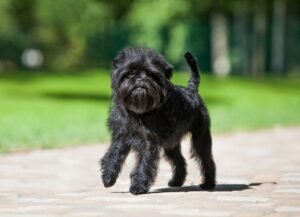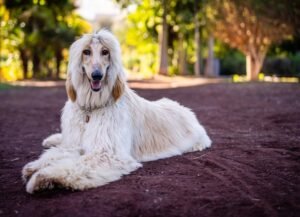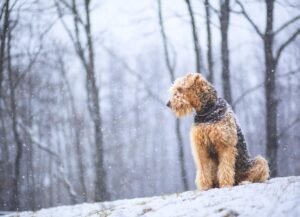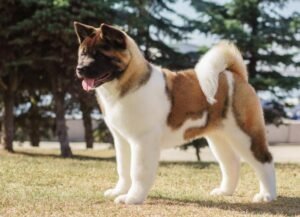The Beauceron (pronounced beau-sir-ahn) was bred to help farmers protect and herd their sheep in central France, according to the American Beauceron Club. But the breed’s skills aren’t relegated to the farm: Beaucerons also served as military dogs during World War I.
The size of a Beauceron is impressive; they can weigh up to 110 pounds and stand as tall as 27.5 inches at the shoulder. Sometimes called the French Shepherd, these herding dogs are very muscular, and require proper training and socialization to be well-mannered throughout their lives.
Caring for a Beauceron
Because of their gentle nature and affection, Beaucerons do well in households that have young children and other dogs. But early training for Beauceron puppies is a must, as this breed has tons of energy and needs to learn how to behave calmly around people and other pets early on.
Beaucerons are herding dogs that need to expend their energy through mental and physical stimulation. Otherwise, they can be destructive if left to entertain themselves. An adult Beauceron should receive at least two hours of exercise daily.
Physically, Beaucerons have a double coat made of short, dense fur. There are four Beauceron color combinations:
No matter your Beauceron’s color, the shedding is excessive. Brushing your Beauceron once or twice weekly can help minimize the fur in your home.
Beauceron Health Issues
Beaucerons are typically healthy dogs that live for 10–12 years. However, some Beaucerons may experience health issues. To minimize risk for some diseases, purchase a puppy from a reputable Beauceron breeder.
Dilated Cardiomyopathy (DCM)
Dilated cardiomyopathy (DCM) is an acquired heart disease in Beaucerons that occurs when the heart becomes enlarged and is unable to function properly. Beaucerons with mild to moderate DCM may be asymptomatic (show no symptoms), while severe DCM symptoms can include:
Your veterinarian can detect a heart murmur, which is often the first sign of DCM. A canine Cardiopet proBNP blood test can also be used to measure heart function. If this test indicates that heart disease is likely, additional testing will be recommended, including an echocardiogram, blood pressure check, and chest X-rays.
Hip Dysplasia
Hip dysplasia is an inherited condition where the femur doesn’t sit properly in the hip joint. As a result, the bone rubs against the hip socket, which over time causes arthritis.
Hip dysplasia can develop in one or both hip joints. Though rare, some Beauceron puppies are born with congenital hip dysplasia. Others can develop this condition during their senior years. Symptoms include:
-
Lameness
-
Slowness to rise from a lying position
-
“Bunny-hopping” gait when running
-
Reluctance to run, jump, or go up or down stairs
-
Holding the affected leg out to the side when sitting up
A PennHIP evaluation allows for early detection and treatment for dogs that have signs of hip dysplasia. Reputable breeders will ensure their Beauceron dogs have PennHIP evaluations as part of their health screening.
Bloat and Gastric Dilatation-Volvulus
Dogs with deep chests, such as Beaucerons, are prone to bloat, a condition where their stomach fills with gas and suddenly makes their abdomen look distended. This condition is uncomfortable, but it is treatable by placing a temporary tube to remove gas from the stomach.
However, bloat can sometimes lead to a life-threatening condition called gastric dilatation-volvulus (GDV), which occurs when a gas- or fluid-filled stomach twists and cuts off blood circulation to the stomach and other organs. GDV is an extremely painful condition that is fatal if emergency surgery is not performed immediately. A veterinarian diagnoses bloat and GDV by conducting a physical exam and taking abdominal X-rays.
To minimize the risk of bloat and GDV in your Beauceron:
-
Have a prophylactic gastropexy (stomach tack) procedure done at time of your dog’s spay or neuter surgery
-
Feed your Beauceron two to three meals a day instead of one
-
Prevent any exercise one hour before and one hour after eating
Canine Copper-Associated Hepatitis
This is a rare condition in Beaucerons in which copper accumulates in the liver, leading to oxidative damage and inflammation. It is unknown if this is an inherited condition in this breed or if it develops secondary to another disease process that obstructs bile flow so the liver cannot properly excrete copper.
Some dogs with copper-associated hepatitis can be asymptomatic, but others may display weight loss, vomiting, decreased appetite, seizures, jaundice (yellow skin tone), and fluid-filled abdomen (ascites).
Blood work, an abdominal ultrasound, and liver biopsy with special staining is needed to diagnose this condition. Treatment varies based on the degree of liver disease, but it may include medications and a special prescription diet.
What To Feed a Beauceron
A Beauceron dog should be fed a high-quality, large-breed dry dog food mixed with some canned dog food. As with all dogs, their daily diet should consist of 90% dog food and 10% treats. Beaucerons should be fed a diet based on their life stage: puppy, adult, or senior.
How To Feed a Beauceron
Beaucerons should be fed a large-breed puppy formula until they are 1 year old. After their first birthday, they should be transitioned to a large-breed adult formula. A senior diet should be started around 6-7 years of age.
To minimize risk for bloat or GDV, the following recommendations can help around mealtime:
-
Feed your dog two to three meals a day, instead of one meal daily.
-
Put the food bowl on the floor at mealtimes; do not use elevated bowls.
-
If there are multiple dogs in the house, feed them separately to minimize stress.
-
Avoid exercise one hour before and after a meal.
-
Add some canned food to the dry food.
-
Do not add water to the dry food, especially if the food contains citric acid.
-
Do not overfeed your Beauceron.
-
Use a slow feeder bowl if your Beauceron eats quickly.
How Much Should You Feed a Beauceron?
Follow the feeding guidelines on the dog food packaging and consult your veterinarian to determine the proper portion size to feed your Beauceron, based on ideal body weight and life stage. Measure the food for each meal to ensure you’re feeding your pup the proper amount.
Nutritional Tips for Beaucerons
Because Beaucerons can weigh over 100 pounds, your vet might recommend starting them on a joint supplement and omega-3 fatty acid supplements. These two supplements will support the joints by minimizing inflammation. Never give your dog supplements unless your vet recommends them.
Behavior and Training Tips for Beaucerons
Beauceron Personality and Temperament
The Beauceron dog breed is known to be very affectionate and loyal toward their family members. They can be good with young children and other dogs when introductions are supervised and done properly. Around new people, Beaucerons can be wary and suspicious. It’s important to socialize Beauceron puppies with new people early so they learn that strangers aren’t scary.
Beauceron Behavior
Beaucerons enjoy playing with family members and other dogs. They can adapt moderately well to change inside or outside the household, such as moving or when a new family member or dog is brought home.
This breed also has a lot of energy and thrives when they have a job that will keep their body and mind stimulated. Without enough mental stimulation, Beaucerons can become destructive.
It’s important to socialize Beauceron puppies with new people early so they learn that strangers aren’t scary.
Beauceron Training
Due to their high intelligence and loyalty to their pet parents, Beauceron puppies are usually easy to train. They should take socialization classes, puppy training classes, and obedience training when young.
Obedience classes will teach a Beauceron puppy to listen to you so you can train them to be calm around children, not to jump up on people, and not to chew on things they shouldn’t. Beaucerons grow up to become strong, large dogs that have a lot of energy, so it’s best to start training when they are puppies.
Fun Activities for Beaucerons
- Agility training
- Carting
- Mushing
- Skijoring (pulling a person on skis)
- Hiking
- Long walks
Beauceron Grooming Guide
Beaucerons have a short, thick coat that consists of two layers: a soft underlayer and a coarse, waterproof topcoat. These dogs shed a lot, so regular brushing (once or twice a week) is important for getting rid of loose hair.
Skin Care
If your Beauceron is dirty or stinky, give them a bath. But frequent bathing isn’t necessary.
Coat Care
This breed does not require professional grooming appointments, but Beaucerons do shed—a lot. Brush them at least once a week to minimize the fur on your floor and furniture.
Beaucerons shed throughout the year, but shedding is at its height during warmer seasons. Because their short fur isn’t prone to matting, you can use a medium-bristle brush or rubber grooming tool to remove their loose fur.
Eye Care
Beaucerons don’t require a lot of eye care, but they may occasionally have normal clear or brown eye discharge. A moistened washcloth can remove any discharge.
Ear Care
Some Beaucerons have environmental or food allergies, which makes them prone to ear infections. For those that have allergies, clean their ears with a routine ear cleaner every two or three weeks, and after baths or other water activities such as swimming.
If a Beauceron shows signs of an ear infection, such as head shaking or pawing at the ears, schedule a vet appointment as soon as possible.
Nail Care
Nails should be trimmed frequently so they don’t overgrow, split, or break. Beaucerons have double dewclaws on their hind limbs; don’t miss these during nail trimming sessions. Overgrown nails can curl and grow into the skin or paw pad if they are not cut routinely.
Considerations for Pet Parents
As members of the herding group, Beaucerons have lots of energy. They need at least two hours of exercise daily, so living in a home that has a large fenced backyard or on a farm would be considered their perfect home.
This breed would not do well in an apartment, small home, or a home without a large fenced-in yard. Beaucerons also need a long walk or hike for exercise every day. If they are not able to release their energy, Beaucerons can become destructive as they try finding other ways to keep themselves busy.
Beaucerons enjoy being around their family as much as possible, so they’ll do best with people who work from home or those who bring their dog along on adventures. All Beauceron puppies should take socialization classes, puppy training classes, and obedience classes so they are well behaved around new people, young children, and other dogs.
Beauceron FAQs
Do Beaucerons bark a lot?
Beaucerons aren’t particularly vocal. But because they were bred to look after their home, they will bark to alert their family if they see anything suspicious or concerning.
What’s the difference between a Beauceron vs. Doberman?
At first glance, the Beauceron may look similar to a Doberman Pinscher. But their looks, jobs, and personalities help differentiate these two breeds.
-
Jobs: The Beauceron is a herding dog best used for rounding up sheep or working closely with police and the military. In contrast, the Doberman is a member of the working group, wherein the main task is to serve as a guardian.
-
Appearances: The Beauceron colors and markings may resemble a Doberman, but their wider face, stockier build, thicker coat, and double hind dewclaws are key differences.
-
Personalities: Both the Beauceron and Doberman are devoted to their family members, but Beaucerons can be more independent-minded when it comes to training and can be destructive if left to their own antics.
Is the Beauceron dog breed rare?
The Beauceron originated in France, where they are a popular and common breed. Outside of France, however, this breed is considered rare.
Featured Image: Adobe/SasaStock
References
Rodrigues A, Leal RO, Girod M, et al. Canine copper-associated hepatitis: A retrospective study of 17 clinical cases. Open Veterinary Journal. 2020;10(2):128-134.




